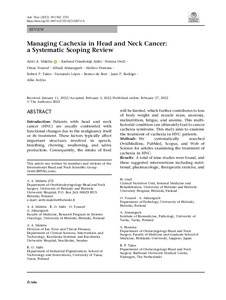Managing Cachexia in Head and Neck Cancer: a Systematic Scoping Review
Mäkitie Antti A; Alabi Rasheed Omobolaji; Orell Helena; Youssef Omar; Almangush Alhadi; Homma Akihiro; Takes Robert P; Lopez Fernando; de Bree Remco; Rodrigo Juan P; Ferlito Alfio
https://urn.fi/URN:NBN:fi-fe2022081154361
Tiivistelmä
Introduction
Patients with head and neck cancer (HNC) are usually confronted with functional changes due to the malignancy itself or its treatment. These factors typically affect important structures involved in speech, breathing, chewing, swallowing, and saliva production. Consequently, the intake of food will be limited, which further contributes to loss of body weight and muscle mass, anorexia, malnutrition, fatigue, and anemia. This multifactorial condition can ultimately lead to cancer cachexia syndrome. This study aims to examine the treatment of cachexia in HNC patients.
Methods
We systematically searched OvidMedline, PubMed, Scopus, and Web of Science for articles examining the treatment of cachexia in HNC.
Results
A total of nine studies were found, and these suggested interventions including nutritional, pharmacologic, therapeutic exercise, and multimodal approaches. The nutritional intervention includes essential components such as dietary counseling, oral nutritional supplements, and medical nutritional support. Individualized nutritional interventions include oral, enteral (feeding tubes i.e., percutaneous endoscopic gastrostomy [PEG], nasogastric tube [NGT]) and parenteral nutrition. The pharmacologic interventions aim at increasing the appetite and weight of cachectic patients. Therapeutic exercise and increased physical activity can help to enhance the synthesis of muscle protein, reducing inflammation and the catabolic effects of cachexia syndrome.
Conclusion
Owing to the multifactorial nature of this syndrome, it is expected that the management approach should be multi-interventional. Early implementation of these interventions may help to improve survival and quality of health and life of cachectic HNC patients.
Kokoelmat
- Rinnakkaistallenteet [27094]
